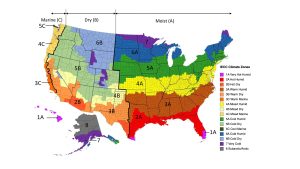This local weather zone map is printed by the American Modern society of Heating and Air-Conditioning Engineers (ASHRAE) and is integrated in the Global Household Code, chapter 11, Strength Effectiveness. ASHRAE’s function is to build expectations of how an engineer or HVAC skilled calculates and designs heating, air conditioning and ventilations units to match the insulation, air sealing, and dampness profile of a building. When building these often-challenging programs, where by the construction is found turns into important, this is the motive the map was made.
The map is damaged down by personal counties in each individual point out by their historic climate facts. Dependent on that details, just about every county is placed in a numbered local climate zone, the numbers start at , which is very hot, (there are no destinations within the United States that have a climate zone designation, nevertheless), and go to weather zone 8, subarctic/arctic (incredibly cold). There are also subcategories to each weather zone indicating whether or not the location is moist, dry or maritime, this final results in 19 diverse weather zones. Texas, for case in point, has several different weather zones both of those in humid and dry groups ranging from weather zone 1 to weather zone 4.
Every single weather zone gets its designation based mostly on historic temperature styles gathered from virtually 5,000 weather sites throughout the US. These sites keep an eye on various distinct metrics, these kinds of as temperature, wind velocity and direction, precipitation, humidity, solar radiation together with other climate-related info. The most pertinent data utilised in establishing the climate zone map is temperature and precipitation.

The thermal requirements column above is based mostly on heating and cooling degree days which is the yearly accumulation of heating or cooling calls for. You will need to have a few definitions to be equipped to interpret the table.
The definition of a cooling diploma day (CCD) is the average necessarily mean day by day temperature higher than a specified temperature. For the function of the local weather zone map, the CDD temperature designation is 50°F. (Not to be puzzled with inside style temperatures for heating and cooling load calculations.) As an illustration, let’s say we have a daily significant temperature of 90°F and a small temperature of 40°F. To calculate the regular necessarily mean temperature, we only add the substantial and reduced temps together and divide by 2.
(90°F + 40°F) / 2 = 65°F
If the final result is higher than the benchmark temperature of 50°F, we subtract the benchmark from the typical mean temperature to calculate the amount of cooling degree days, for the preceding case in point, the calculation would be:
65°F – 50°F = 15 CCD
Equivalent to cooling diploma days, a heating degree working day (HDD) is the common mean day by day temperature underneath a specified temperature. 65°F is the benchmark temperature applied for the HDD calculation. As an case in point, if the ordinary signify everyday temperature is 0°F, there would be 65 heating diploma times for that day in that area.
65°F – 0°F = 65 HDD.
To compute the total cooling degree days for a given area above the system of a yr, you only include all the daily CDD values with each other for the yr. The exact same system is used to calculate the overall yearly HDD. Utilizing climate zone 5 as an illustration. To slide into that weather zone, the cooling diploma days need to be larger than 6,300 and heating diploma days need to be much more than 5,400 but a lot less than or equivalent to 7,200.
The other section of the local climate zone designation has to do with rainfall amounts for a specified location. Moist is thought of any spot that gets additional than 20 inches of rainfall each year. Dry is, you guessed it, less than 20 inches of rainfall for a offered location. The maritime zone is a minor extra challenging. In accordance to The Division of Electrical power, “A maritime local weather is normally described as a area that meets all of the following criteria:
A mean temperature of coldest month amongst 27°F and 65°F
A warmest month imply of less than 72°F
At least 4 months with a necessarily mean temperature extra than 50°F
A dry time in summer season. The thirty day period with the heaviest precipitation in the cold season has at the very least three periods as a lot precipitation as the month with the minimum precipitation in the relaxation of the year. The chilly period is October by means of March.”
Seeking to estimate all these metrics manually for the reason of being aware of your local climate zone would get a whole lot of work, simply looking at the map, or wanting up the condition and county info in the 2021 IRC, Table N1101.7, Local climate Zones, Humidity Regimes and Warm Humid Designations by Condition, County and Territory is substantially less complicated.
So, what do we get out of being aware of our weather zone? The Electricity Effectiveness section (chapter 11) of the International Household Code is where by insulation needs, air sealing prerequisites and programs masking HVAC techniques are included in the codes. Lots of of the quantifying specifics are based on the local climate zone of the property. If you are living in local climate zones 7 or 8 for example, insulation and air sealing will be much more sturdy than households developed in climates zones 1 or 2.
It’s really hard to imagine that our latest weather zone map based on historic local climate details has only been around for the past 20 a long time. 2004 was the year it was 1st revealed as a nutritional supplement to the Intercontinental Electrical power Conservation Code (IECC). The map illustration over is from the most recent addition of the IRC at the time of this composing, 2021. Some locations may be working with this map for code requirements, others may well still be using the initial model from 2004. We’ve seen some big improvements in how we tackle energy performance in our buildings, the latest local weather zone map has drastically simplified that course of action.
The post Why Understanding Your Climate Zone is Important first appeared on Northern Designed.

